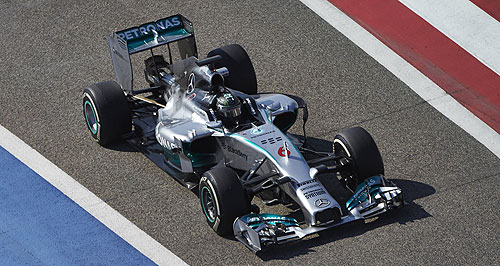News - General News - TechnologyRace technologies could make cars saferSafety first: A layer of a fabric called zylon has helped to transform F1 safety, a Melbourne conference has been told. Formula One safety advances a clue to safer road cars: FIA official12 Mar 2014 By IAN PORTER ADVANCES made in Formula One race car construction since Ayrton Senna died 20 years ago have not only transformed track safety but could also have a similar effect on passenger cars, according to a leading motor sport official. Indeed, Australian driver Mark Webber would almost certainly have died in his enormous 2010 crash during the Spanish Grand Prix had safety standards not been greatly increased by the Federation Internationale d’Automobile (FIA) in the period after the death of Senna and Roland Ratzenberger on the same weekend in 1994. The prevention of further deaths in what is considered the world’s most dangerous sport is a cause of some pride, Garry Connelly told the Cars of Tomorrow conference in Melbourne. “It’s been a deliberate strategy, a Formula Zero strategy, which I believe has relevance to all disciplines of motor sport and to road-going activities,” he said. The safety improvements are the result of work by the FIA Institute for Motor Sport Safety and Sustainability, where Mr Connelly is deputy president. He is also an FIA steward at the World Rally, World Touring Car and Formula One championships. Mr Connelly said extensive testing by the institute had discovered that coating an F1 car’s carbon fibre tub with a 6mm thick layer of zylon changed a fatal side impact accident from a fatal crash to one where a driver could walk away. “That’s quite remarkable,” he said. “Add a €40 ($61) piece of fabric and suddenly you have gone from a fatal accident to a walk-away situation.” Mr Connelly said the institute also revised the standard for the driver’s seat that, under 1999 rules, had to be able to withstand a side impact of 24G (24 times the force of gravity). He said crashes were registering higher loads than that, so the institute decided to ramp up the minimum standard to 70G. The first test completely ruined a €20,000 crash test dummy and would have been unsurvivable. “Does this have roadgoing application?,” he said. “I would think it does.” Similarly, the institute wanted to minimise the dangers of a side impact for rally cars, where there is only a 200mm distance between the point of impact and the driver or navigator. The maximum survivable impact speed was considered to be 32km/h. Mr Connelly said making the car rigid would only transmit all the forces to the passengers, so the institute looked for an energy-absorbing solution. Data recorders show most impacts were about 60km/h. “Our guys came up with a wafer system, a laminate system of metal and foam and, in this case, at 60km/h, they discovered it was survivable, and possibly a walk-away,” he said. While the laminate structure was impractical for production cars, the institute worked with some foam manufacturers to come up with some specifications of foam which, when placed inside the door skin, would absorb that kind of impact. Mr Connelly said composite materials also had enormous potential. “I believe we will start to see more and more carbon-fibre used in unusual places in the automotive industry coming out of what we have done in motor sport,” he said. “There is no reason why you can’t legislate, if you have the will, to make cars a lot safer than they are.” Mr Connelly also said the radical new engines to be seen for the first time at the Australian Grand Prix will also promise great benefits for production cars. The new drive trains incorporate a 1.6-litre turbo-charged engine fitted with two energy recovery systems: a kinetic energy recovery system already seen on earlier F1 cars and a heat recovery system which converts exhaust heat into electricity. The kinetic recovery system generates electricity from the rear wheels when the driver is braking and the heat recovery system generates electricity from the exhaust flow through the turbo-charger when the car is accelerating. “Is this technology transferable? Absolutely. It has been that way for decades and will continue to be.” While he system is complex, the manufacturers claim they have already beaten the FIA’s horsepower target, which was to match the 2013 output of around 700hp (521kW). Mr Connelly pointed out that these new engine regulations would be backed up by a dramatic reduction in fuel allowance, which will be reduced from 140kg a race to 100kg. “They are using less fuel and making more power,” he said “It’s a great outcome.” Mr Connelly said the two energy recovery systems together produced around 161hp (120kW) for 33 seconds a lap, which was about how long cars were under full acceleration. “That’s 161hp recovered from stuff that would have been wasted previously,” he said. But there will be a downside, at least in the early races. “The teams have had each car’s engine allocation from eight to five this year, so they have got to make them reliable,” Mr Connelly said. “But I wouldn’t go placing a lot of money on your favorite driver this weekend until we see the reliability of the cars during practice. “I think we will have a few little hiccups in the first few races. Hopefully not.”  Read more |
Click to shareGeneral News articlesResearch General News Motor industry news |

















Facebook Twitter Instagram